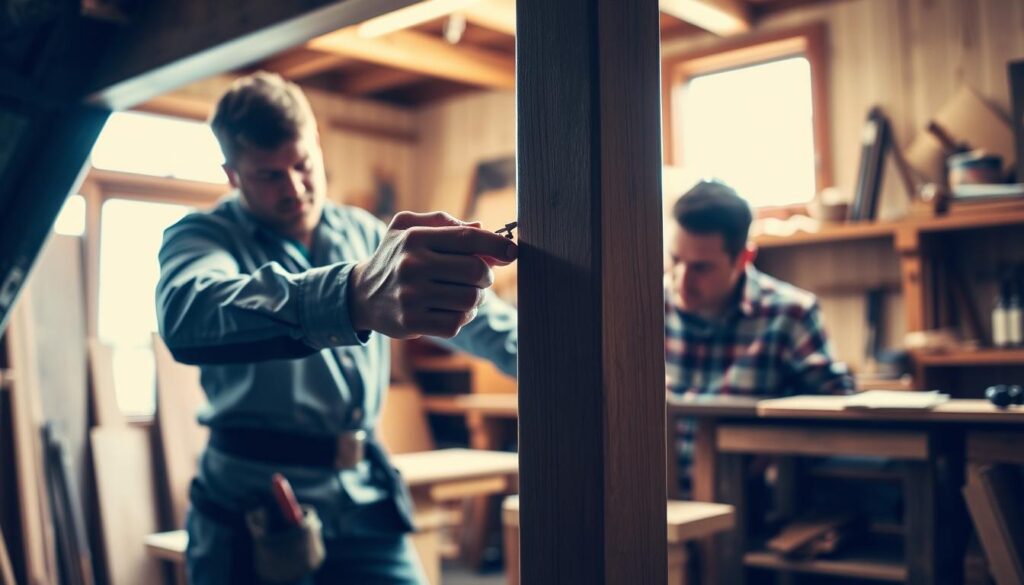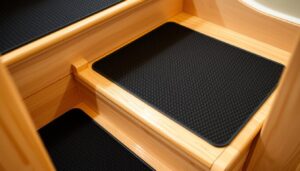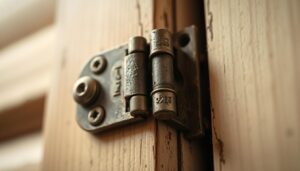Are you tired of a wobbly handrail that’s more of a hazard than a help? A loose bannister isn’t just an annoyance; it’s a serious safety concern that needs immediate attention. Whether you’re dealing with a rickety staircase or a wobbly connection, it’s essential to address the issue promptly.
You don’t need to be a professional to fix the problem. With basic DIY skills and common household tools, you can restore stability to your staircase. Our comprehensive guide will walk you through identifying the issue, gathering the right tools, and implementing effective fixes for both wooden and metal bannister systems.
Key Takeaways
- Identify the cause of a loose handrail and address it promptly.
- Gather the necessary tools to fix the issue.
- Implement effective fixes for wooden and metal bannister systems.
- Restore stability to your staircase with basic DIY skills.
- Save hundreds of pounds on professional repairs.
Understanding the Problem: Why Bannister Rails Become Loose
A wobbly stair railing is not just annoying, it’s a safety concern. Many homeowners experience the frustration of loose bannister rails, which can become loose over time due to various factors.
Common Causes of Loose Bannister Rails
Several factors contribute to bannister rails becoming loose. These include:
- Regular use and daily wear on handrail components.
- Vibrations from home renovations or construction work.
- Natural expansion and contraction of materials due to seasonal changes.
- Poor initial installation techniques or inadequate fixings.
Safety Concerns with Wobbly Railings
Wobbly railings pose significant safety risks, particularly for vulnerable individuals such as children and the elderly. A looseose bannister rail can lead to falls and serious injuries if not addressed promptly. Even minor wobbling indicates a developing problem that will worsen without intervention, potentially leading to complete failure of the handrail system.
For instance, daily use puts constant pressure on handrail components, gradually loosening connections between spindles, newel posts, and the handrail itself. Ensuring the stability of your stair railing is crucial for household safety.
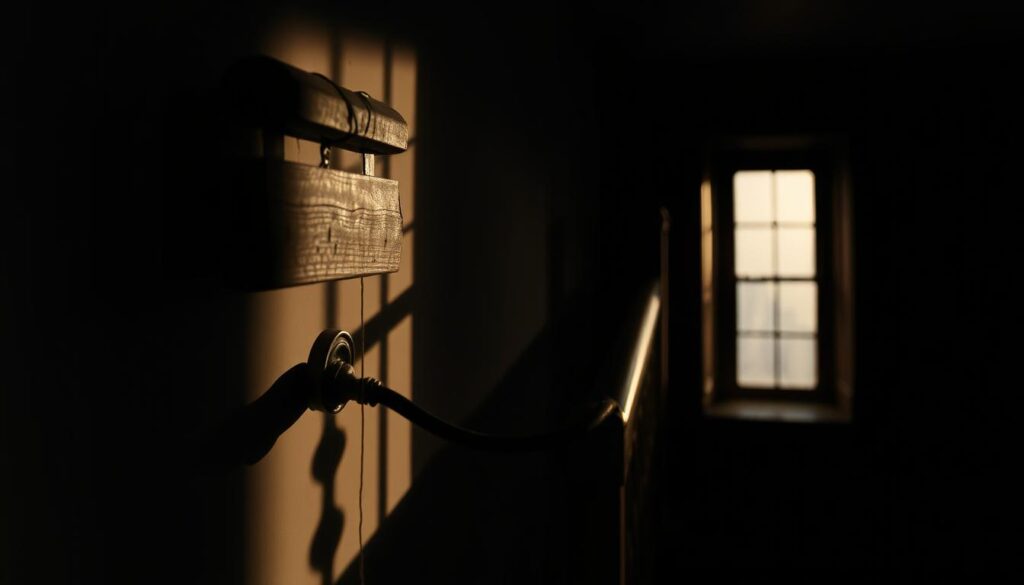
Tools and Materials You’ll Need to Repair Loose Bannister Rails
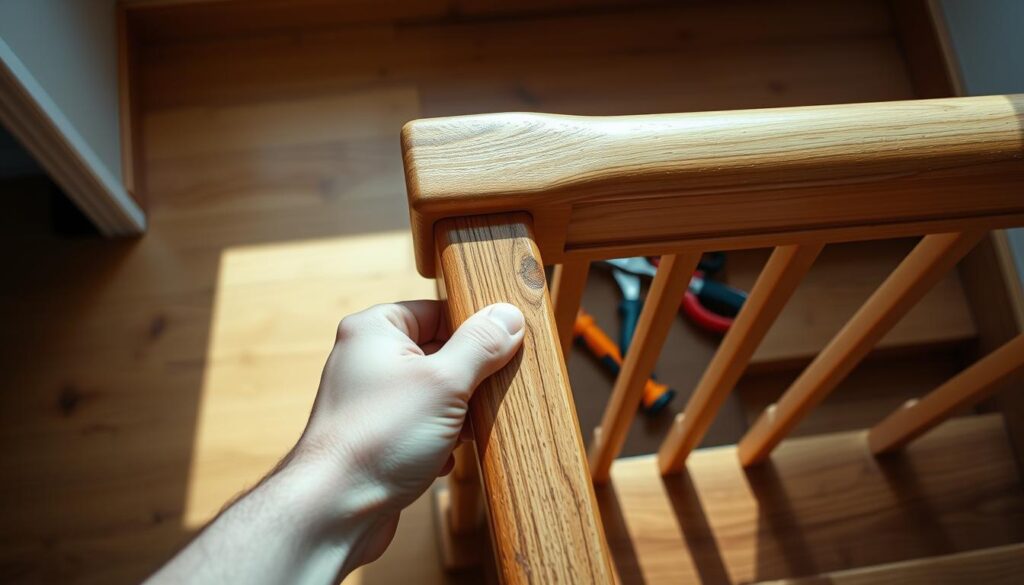
To successfully repair your loose bannister rail, you’ll need to prepare the necessary tools and materials in advance. Having the right equipment will make the repair process much more efficient and lead to better results.
Essential Tools for the Job
Before beginning your repair work, gather all the necessary tools, including a screwdriver (both flathead and Phillips), drill with various bits, hammer, nail punch, measuring tape, and level. You may also need clamps or temporary bracing materials to hold components in place while adhesives dry or when installing new hardware.
Materials for Different Types of Repairs
For wooden handrail repairs, you’ll need wood glue specifically designed for joinery, wood filler for covering holes, fine-grit sandpaper, and potentially wood shims for filling larger gaps. For metal handrail repairs, you’ll need different materials such as replacement grub screws, Allen keys in various sizes, metal brackets, and potentially a metal file for adjustments.
Consider using specialized products like “Chair Doctor Glue” which makes wood swell within joints before binding components together—ideal for minor gaps in wooden spindles. Ensure you have cleaning supplies ready, including a damp cloth for wiping excess glue and cleaning surfaces before applying adhesives.
Assessing Your Loose Bannister Rail: Identifying the Issue
To repair a loose bannister rail, you must first assess the issue to choose the the right fix. Before diving into any repairs, it’s essential to determine what’s causing the wobble. Common causes include loose screws, damaged mounting brackets, or weak wall anchors. In some cases, the handrail itself may be damaged, or the wall behind it may not be properly supporting the handrail. The issue could also stem from worn-out wood glue or connectors, particularly with older staircases.
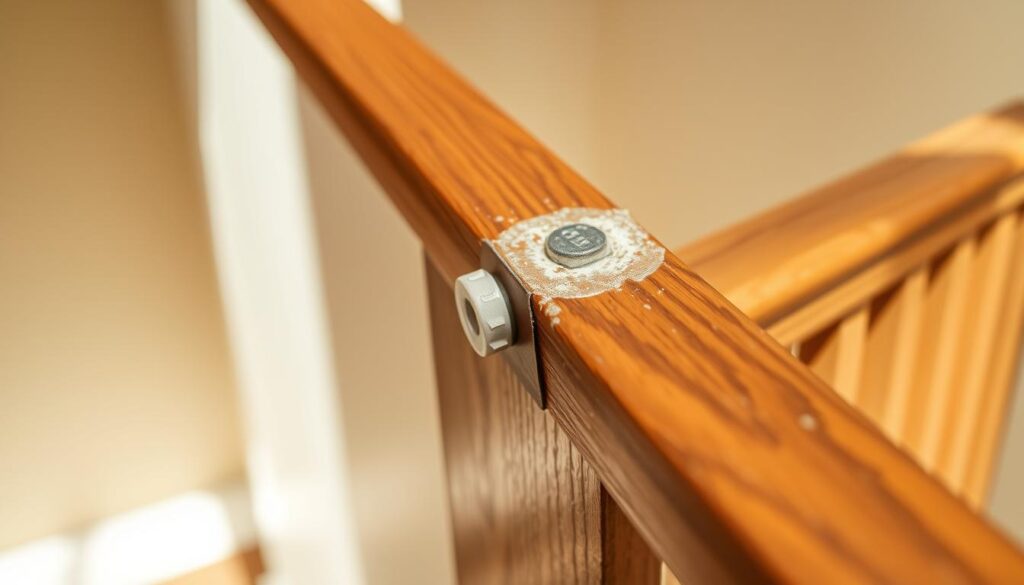
Checking for Loose Screws and Brackets3>
Begin your assessment by systematically checking each component of your stair bannister system, starting with a visual inspection followed by a physical test of stability. Examine all visible screws and brackets along the handrail, paying special attention to connection points where the rail meets newel posts or wall mounts.
Examining Wooden Spindle Connections3>
Test wooden spindle connections by gently applying pressure from different angles—even small movements indicate loosening that needs addressing. For wooden components, look for gaps in joints, dried or cracked glue, or areas where the wood has shrunk away from its original position.
Inspecting Metal Spindle Attachments3>
When inspecting metal spindle attachments, check for loose grub screws (small screws that secure the spindle in place) which are a common failure point. Wall-mounted handrails often become loose at the bracket points—check if the screws are pulling away from the wall, which may indicate the need for better anchoring.
| Component | Common Issues | Inspection Tips |
|---|---|---|
| Wooden Spindles | Gaps in joints, cracked glue | Check for movement, inspect glue condition |
| Metal Spindles | Loose grub screws | Tighten grub screws, check for damage |
| Brackets and Anchors | Loose screws, weak anchors | Inspect screw tightness, anchor condition |
Understanding exactly what type of looseness you’re dealing with will help you select the most appropriate repair method and avoid unnecessary work. By carefully inspecting the railing’s joints, brackets, and the point where it attaches to the wall, you can identify the root cause and fix loose the bannister rail effectively, ensuring it is secure and stable in its place.
How to Repair Loose Wooden Bannister Rails and Spindles
To maintain the integrity of your staircase, it’s essential to know how to repair loose wooden bannister rails and spindles. Over time, the constant use and wear and tear can cause the wooden components to loosen, but with the right techniques, you can secure them effectively.
Fixing Loose Spindles in Handrail Grooves
Loose spindles in handrail grooves can be fixed using different methods depending on whether you’re working with softwood or hardwood. For softwood spindles, the nail method is effective.
Using the Nail Method for Softwood Spindles
To secure softwood spindles, drive 1.5″ nails at a 45-degree angle through the side of the spindle into the handrail or base rail. Make sure to work carefully to avoid splitting the wood, and use a nail punch to countersink the nail below the surface for a clean finish.
The Drill and Screw Method for Hardwood Spindles
For hardwood spindles, which are denser and more prone to splitting, the drill and screw method is more effective. Drill a pilot hole slightly smaller than your screw diameter, then insert the screw. Use a countersink bit to create a recess for the screw head, allowing it to sit flush with or below the surface of the wood.
Repairing Loose Joints with Wood Glue
For loose joints between larger components like newel posts and handrails, wood glue provides an excellent solution. Apply glue to the joint, clamp firmly, and allow sufficient drying time. When using wood glue for repairs, make sure to clean the joint surfaces first and remove any old, dried glue to ensure proper adhesion.
- For small gaps, consider using specialized expanding wood glue that can be injected into the crack, creating a strong bond.
- After completing repairs, allow sufficient time for adhesives to cure completely before subjecting the railing to normal use.
- For more detailed guidance on fixing wooden spindles, you can visit fixing wooden spindles.
Fixing Metal Spindles and Hardware Issues
Loose metal spindles can compromise the integrity of your bannister rail; here’s how to fix them. Metal spindles are a crucial component of many handrail systems, providing both support and stability. When these spindles become loose, it can lead to a wobbly handrail, which is not only annoying but also poses a safety risk.
Tightening Loose Grub Screws in Metal Spindles
To fix loose metal spindles, you first need to locate the grub screw hole, typically found on the bracket or collar that holds the spindle. If the grub screw is present but loose, use an appropriately sized Allen key to tighten it firmly. Make sure not to overtighten, as this could strip the threads. If the grub screw is missing, you’ll need to source a replacement of the correct size and thread.
- Check if the grub screw is present or missing.
- If present, tighten it using an Allen key.
- If missing, source a replacement.
Replacing Damaged Brackets and Wall Anchors
For brackets that have pulled away from the wall, remove the existing screws and check if the wall material is still solid enough to support the handrail. When reinstalling wall brackets, make sure to use appropriate anchors for your wall type. For masonry walls, use plastic wall plugs, and for hollow walls, use toggle bolts. If the metal bracket itself is bent or damaged, it’s usually best to replace it entirely.
For more detailed guidance on fixing loose or wobbly stair railings, you can visit this helpful resource. After completing repairs to metal components, check the entire handrail system for stability by applying moderate pressure at various points along its length.
Conclusion: Maintaining Your Bannister Rail for Long-Term Safety
To keep your staircase safe and sturdy, regular maintenance of the handrail system is essential. This involves checking for loose components every few months, especially in homes with active children or heavy stair traffic.
Preventative measures are more effective than repairs. Tightening any slightly loose screws or fittings before they develop into more serious problems can save time and effort in the long run. It’s also helpful to keep a record of the specific sizes and types of fixings used in your bannister installation to make future maintenance quicker and easier.
For wooden components, periodic application of appropriate wood polish or oil can prevent drying and shrinkage that leads to loose joints. Be mindful of excessive weight or pressure on handrails, as this can accelerate wear and loosen fixings over time. Consider applying a small amount of thread-locking compound to metal screws in high-vibration areas to prevent them from working loose.
By following these tips and maintaining a basic repair kit, including wood glue, spare screws, and touch-up paint or stain, you can address minor issues quickly. If DIY repairs don’t fully resolve stability issues, or if you’re unsure about the structural integrity, don’t hesitate to call a professional. By doing so, you can maintain a safe, sturdy staircase that will serve your home well for many years to come.
